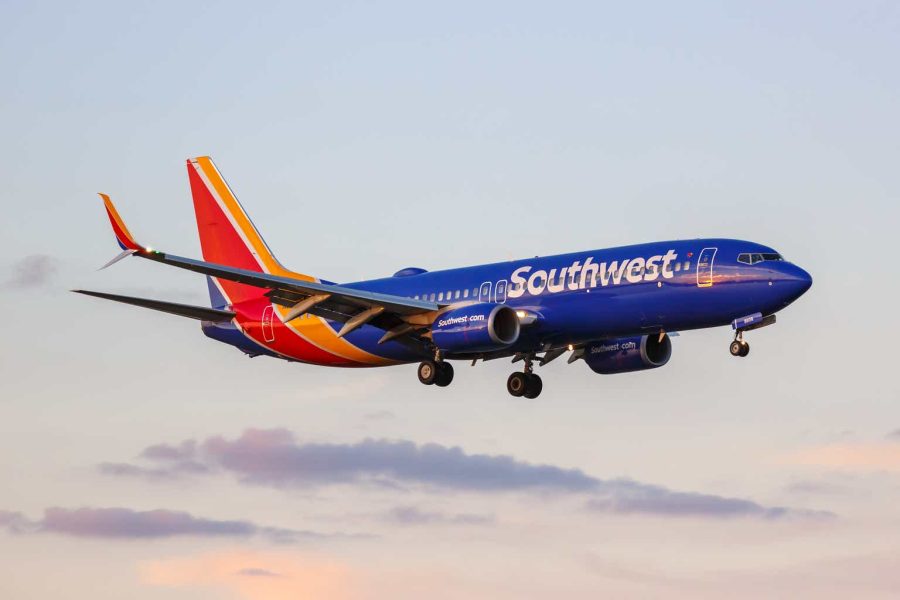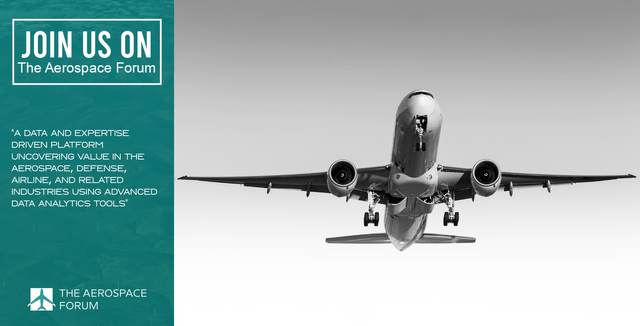Summary:
- Last year’s holiday travel season was plagued by delays, and Southwest Airlines performed poorly due to scheduling and software issues.
- This year’s Thanksgiving travel demand is expected to increase, with more flights and passengers, but no major weather events.
- Southwest Airlines is facing potential pilot strikes due to ongoing negotiations over pay, which could impact the late December travel period.
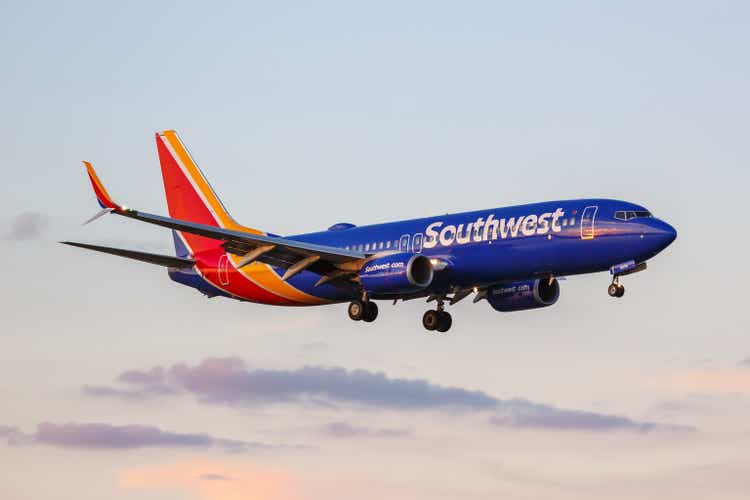
Boarding1Now
Last year’s Q4 holiday travel season was packed with delays due to a combination of airplane shortages, pilot shortages, tight scheduling, ATC shortages and weather events. One airline that performed particularly bad was Southwest Airlines (NYSE:LUV). The airline was a step or two behind on implementing sufficient padding and its network had proven to be too complex to be handled by its scheduling software. The consequence was that in the case of an adverse event, Southwest Airlines had no other choice than performing a hard reset on its entire operations.
In this report, I will analyze what we could be expecting from this holiday travel season, where Southwest Airlines has improved and where it has not.
What To Expect From The Thanksgiving Holiday Travel Demand?
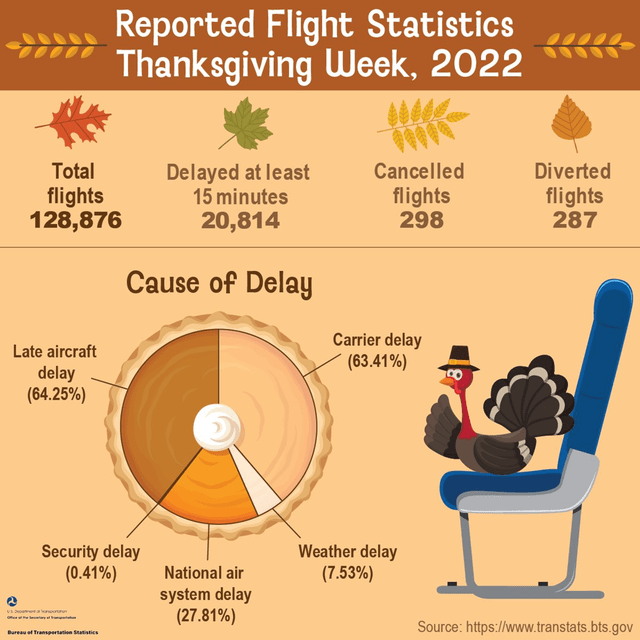
FAA
Q4 consists of two travel peaks, the first one is the Thanksgiving peak and the second one is the Christmas holiday travel peak. Last year’s Thanksgiving week saw nearly 129,000 flights with more than 15% of the flights being delayed 15 minutes or more and 0.2% of the flights being cancelled. How the Bureau of Transportation Statistics constructed the cause of delay “pie” is not quite a useful one as the cause of delay adds up to well over 100%. Certainly, there’s overlap but it’s simply not useful to present it like this.
This year’s holiday travel will see a storm that could bring some adverse weather events, but nothing to the scale of the December storm witnessed last year December.
With no major widespread weather events expected, it’s time to turn to the travel volume. For the Thanksgiving holiday, AAA is projecting 2.3% more travelers including 6.6% more passengers carried by air but projections from airlines point at 9% more passengers. This is where we can actually start tying things to availability of airplanes to see whether there’s any reason for concern in terms of capacity. I’m not using the reported flight statistics for 2022 as a baseline because although it’s labeled as a week worth of flight data. It seems that’s merely covers several days.
I have used the nine days around Thanksgiving in 2022 and 2023 as a baseline and observed the following:
- 7.5% more flights are planned in the nine days around (and including) Thanksgiving.
- Four percent more flights are planned in the three days prior to Thanksgiving.
- 2.4% more flights are planned prior to Thanksgiving.
- On Thanksgiving, 62.3% more flights are planned.
- 4% more flights are planned at the busiest day.
- 3.7% more flights are planned excluding the day of Thanksgiving.
So what we’re seeing is that the big increase in scheduled flights is primarily caused by a significant increase in scheduled flights on Thanksgiving itself. Overall, we’re seeing 9% more air travelers on 7.5% more flights. So, flights are expected to be fuller on average. Most recent data from Southwest Airlines showed a 2.7% increase in passengers carried for Q3 2023 and an 8.1% increase in passengers carried for the nine months ending September while having 10% more airplanes and 12.5% more capacity and for the fourth quarter. Southwest Airlines has guided for 21% higher capacity on an adjusted basis to filter out the December 2022 flight disruptions. So, on 9% more travelers for the US airlines, it will be busy. But I don’t see any major problems as the fleet has grown to handle the increased demand.
Southwest Airlines Is Not Out Of Trouble: Pilots Are Ready To Strike
While I do not expect Southwest Airlines to face major challenges for what’s set to be a record-breaking Thanksgiving holiday, there are challenges which could affect the second travel period around Christmas. Southwest Airlines has improved its optimization plan including improvements for winter operations, crew scheduling, network planning and better procedures in case of severe weather disruptions. Whether that action plan will be effective, if needed, remains to be seen. The bigger threat seems to be the ongoing negotiations with its pilots, which have not been fruitful so far. The airline did reach an agreement with its flight attendants in October after earlier agreements with mechanics as well as material specialists.
The good news for Southwest and its pilots is that there has been progress over the past several months. The pilot union generally is looking for better scheduling, improvements in technology to improve operational reliability and better conditions and pay for pilots.
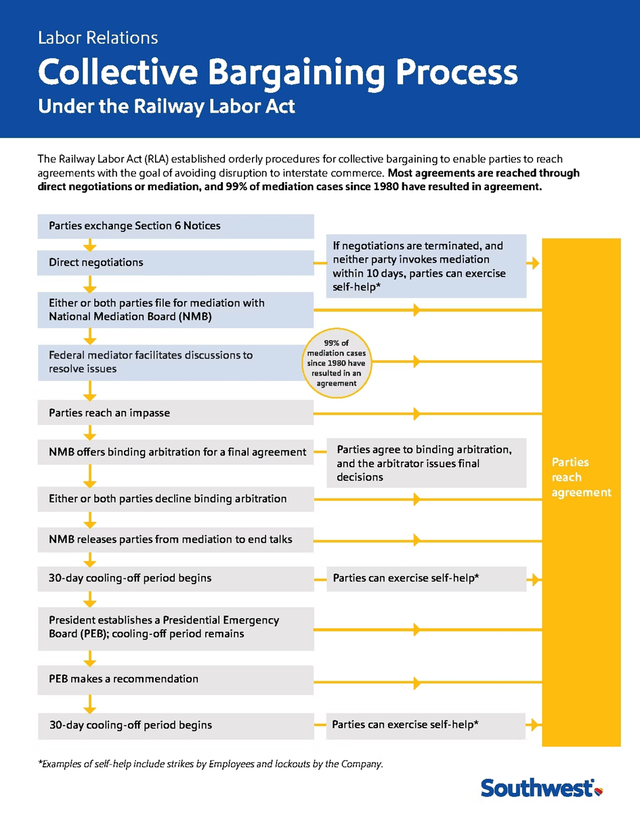
Southwest Airlines
The current negotiations between SWAPA and Southwest are overseen by federal mediators under the Railway Labor Act and are expected to yield an agreement by 30th of November. Under the Railway Labor Act, in case negotiations reach an impasse there is a 30-day cooling period before a strike can commence. So, I would say that chances of a widespread disruption during the December travel period are declining with each day that Southwest Airlines and SWAPA are in mediation as a 30-day window from the 30th of November would indicate a strike can only start late December. This, however, would still impact the tail of the December travel period into January and if SWAPA is released from mediation in the coming days that could more significantly impact the December travel period.
So, the big risk for the December travel period having extended impact hinges mostly on a release from mediation in the coming days. In preparation for a potential strike, SWAPA has opened its first strike center which also serves as an indication that while there is progress in the negotiations it is not going fast enough. The opening of the strike center puts additional pressure to get Southwest Airlines to come up with a workable agreement on short notice. All of this means that while the chances of a strike in the December peak travel period seems to be significantly lower, the chance of a strike is still there in case of early mediation exit or if there’s no agreement by the end of November.
Southwest Airlines Pilot Pay Is Not Competitive
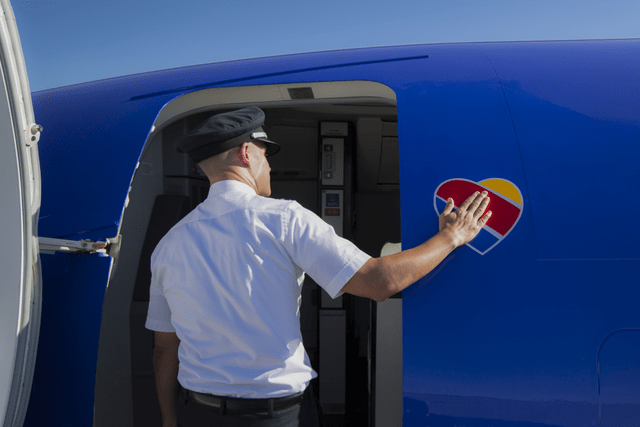
Southwest Airlines
While SWAPA has reasons that go beyond pay to eventually strike, for Southwest Airlines this seems to be all about the pay, and one can wonder whether Southwest Airlines is doing the smart thing here. I would say that’s not the case. With most major carriers having an agreement with pilots in place, Southwest’s leverage has been decreased and one can wonder what’s taking them so long to prepare an acceptable package for pilots as timing hasn’t been in their favor for a very long time now.
It’s difficult to make an apples-to-apples comparison for pilot pay as there are multiple factors involved such as seniority and aircraft type operated. The average pilot pay in the US is $107,395 and Southwest Airlines pays its pilots an average of $107,823 which means that Southwest Airlines has an average pay and that surely does mean that the grass is greener on the other side which provides challenges to retain pilots or hire new ones. This effectively puts any money Southwest Airlines spends on training staff at risk as its pay is simply not competitive and it also makes the process and success in hiring more challenging. United Airlines pilots received a 21% increase in salaries and the average pay is now around $142,500 with a total multi-year increase of 46% for pilots. This of course also includes pilots for wide body airplanes of which Southwest Airlines has none, but if we check for instance the JetBlue (JBLU), which only has single aisle airplanes, the average pay is $130,775 which is 21% higher than what Southwest Airlines are getting. So, the reality almost is that Southwest Airlines is not admitting the reality that its pay is not attractive at all, and it could hurt the value of the company.
It’s About The Pilot Pay For Southwest Airlines
For Southwest Airlines, it’s all about the pay, it seems, as it would significantly increase costs. We can’t know how much the cost increase would be for Southwest Airlines but we can refer to other airlines to have an indication and then circle it back to Southwest Airlines.
United Airlines saw its third quarter salaries increase by 37% on the back of a higher headcount and increased profit sharing and a new profit sharing formula. Backing out the increased headcount, we would get to 23% higher costs which would include higher pay and higher profit sharing. Excluding profit sharing, it would be around 14% higher year-over-year. Doing the same calculation for Delta Air Lines (DAL) would result in around 7.5% higher costs. Both airlines have pilot agreements that have an immediate increase in pay of around 20%.
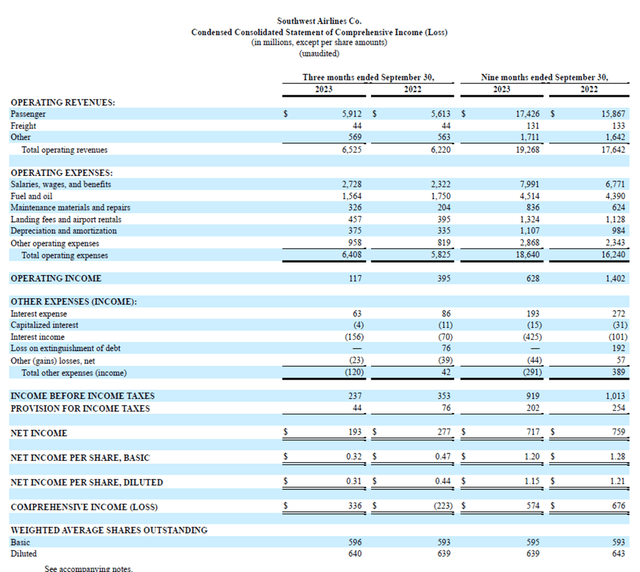
Southwest Airlines
If we look at Southwest’s Q3 2023 results, we can see the salaries increased 17.5%, but this is driven by a 15.7% increase in headcount. During the quarter, fuel prices increased by $186 million while operating profit decreased $278 million. If we apply increases to salaries excluding profit sharing in line with what we saw at United Airlines and Delta Air Lines, the salaries, wages and benefits would increase to roughly $2.9 billion to $3.1 billion or a 6% to 12% increase compared to what the company reported in the third quarter. So, the cost would go up around $155 million to $330 million with a midpoint of $242.5 million. Keeping in mind the $278 million decrease in operating profit, it basically means that Southwest’s earnings model would be pretty much broken because the combination of a lower fuel bill and higher labor costs would indicate that Southwest Airlines Q3 2023 earnings would indicate a $38 million to $213 million operating loss. So, one also could make a point for Southwest Airlines not being as flexible as desired on amending the pilot agreement as we’re already seeing a distortion in historical relative costs of labor. With fuel prices heading higher, which was a big plus for airlines in the first nine months of the year, that cost balance becomes increasingly more problematic as we’re already seeing domestic revenues weakening somewhat.
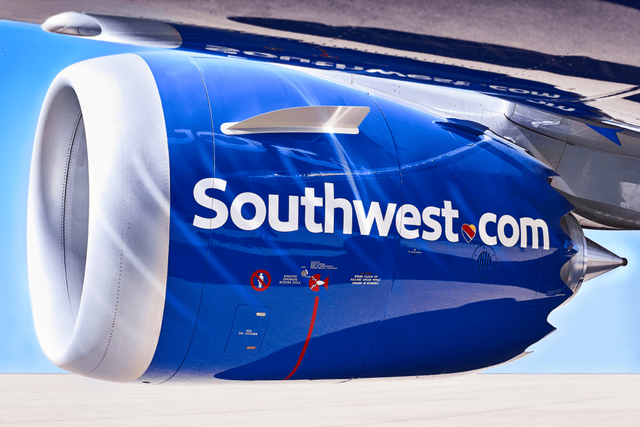
Southwest Airlines
So, Southwest Airlines is trapped here. Not agreeing on a much-needed pilot agreement will hurt the growth prospects of the company over the longer term and a strike would cause bigger issues in the near future, but agreeing on the pilot agreement also would bring a more challenging cost environment for the carrier. Southwest Airlines can’t win in this, it seems. But in that case, it has to choose for a new labor agreement with pilots, absorb the costs to some extent and see how much it can pass through on passengers until the air travel market rationalizes from revenue and cost perspective. Perhaps that’s the price a carrier like Southwest has to pay for being awfully late to reach an agreement with the people who are supposed to fly the planes. Low-cost operations are all about scaling the business and just ordering airplanes from Boeing does not mean you can achieve scale if you don’t have the pilots to fly those airplanes.
Southwest Airlines Stock: A Buy, Sell or Hold?
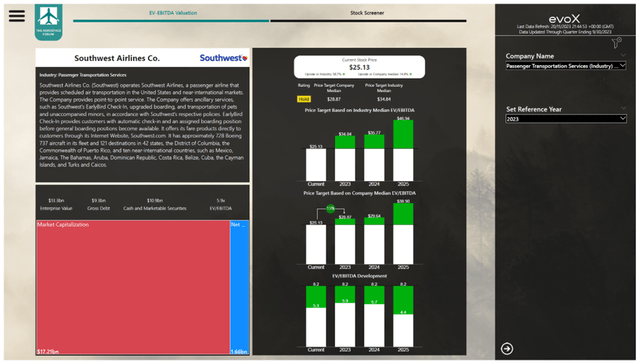
The Aerospace Forum
The big question of course is whether the stock is a buy, sell or hold. I previously had a buy rating on the stock. Since then, I have started utilizing a stock screener to more objectively provide a rating for stocks based on balance sheet data and forward projections. Using this model, Southwest Airlines can be marked a Hold but with 15% upside. Positives for Southwest Airlines are a net cash position with no significant debt maturing until 2025.
Conclusion: Southwest Airlines Stock Has Upside But Prolonged Negotiations Are An Overhang
I believe that Southwest Airlines stock has upside. For the Thanksgiving travel period I’m not expecting major disruptions and the company also should be better prepared for the December travel period. Whether that’s the case of course remains to be seen in the event of disruptive weather. The bigger issue right now is that the company is dragging on negotiations with SWAPA. Mediation is set to end by the end of November, which in case of an agreement likely will reflect positively on the stock price. Not reaching an agreement on or prior to the 30th of November and an exit from mediation could result in a strike during the December travel period. The objective seems to be to reach an agreement by the 30th of November, but I would also not be surprised if we would see Southwest Airlines being slow on actually reaching an agreement as fuel prices have been heading higher and a strike late in the travel period would be less effective. From there, Southwest could make the argument that costs have been increasing and a new agreement would not make the airline more competitive.
However, that’s an argument I’m not buying for the simple reason that not doing anything is not an option and the airline already spent too much time doing nothing to make the pay more attractive for Southwest Airlines pilots, which threatens the competitive position of the company altogether until there is some rationalization on cost in the industry. So, not doing anything is not an option. It’s problematic for all stakeholders involved that Southwest Airlines’ board seems to be living in a different reality.
Analyst’s Disclosure: I/we have no stock, option or similar derivative position in any of the companies mentioned, and no plans to initiate any such positions within the next 72 hours. I wrote this article myself, and it expresses my own opinions. I am not receiving compensation for it (other than from Seeking Alpha). I have no business relationship with any company whose stock is mentioned in this article.
Seeking Alpha’s Disclosure: Past performance is no guarantee of future results. No recommendation or advice is being given as to whether any investment is suitable for a particular investor. Any views or opinions expressed above may not reflect those of Seeking Alpha as a whole. Seeking Alpha is not a licensed securities dealer, broker or US investment adviser or investment bank. Our analysts are third party authors that include both professional investors and individual investors who may not be licensed or certified by any institute or regulatory body.
If you want full access to all our reports, data and investing ideas, join The Aerospace Forum, the #1 aerospace, defense and airline investment research service on Seeking Alpha, with access to evoX Data Analytics, our in-house developed data analytics platform.
